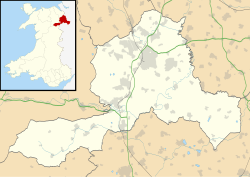Penley
| |
|---|---|
 The Dymock Arms public house in Penley | |
Location within Wrexham | |
| Population | 606 |
| OS grid reference | SJ414399 |
| Community | |
| Principal area | |
| Country | Wales |
| Sovereign state | United Kingdom |
| Post town | WREXHAM |
| Postcode district | LL13 |
| Dialling code | 01948 |
| Police | North Wales |
| Fire | North Wales |
| Ambulance | Welsh |
| UK Parliament | |
| Senedd Cymru – Welsh Parliament | |
Penley (Welsh : Llannerch Banna) is a village in the County Borough of Wrexham, in Wales close to the border with Shropshire, England, and had a population of 606 as of the 2011 census. [1]
Contents
The village was, until 1974, in an exclave of the ancient county of Flintshire known as Maelor Saesneg . [2] (English: "English Maelor"), sometimes called "Flintshire Detached", which was administered from Overton-on-Dee. Between 1974 and 1996, Penley was in the short-lived county of Clwyd.
Penley lies on the path of the long-distance walk, the Maelor Way . [3]

